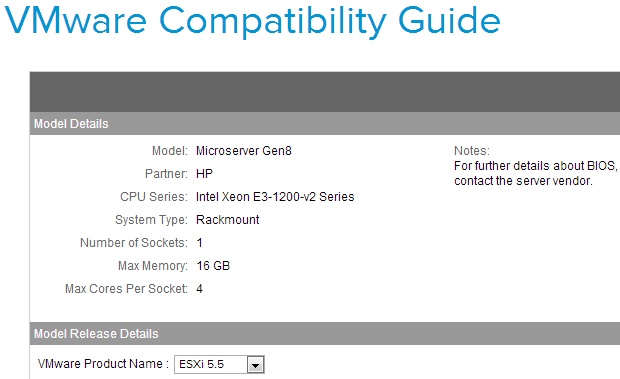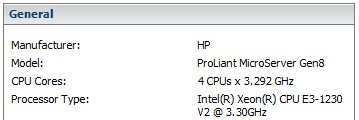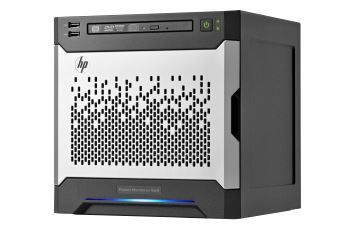Hewlett Packard has updated its widely distributed Microserver Series to Gen8. This extremely affordable server which was initially made for SMB and home servers has become very popular in the virtualization scene. Due to its low price and power consumption, you can find this system in many virtualization home labs. The Generation 8 Microserver (Gen8 or G8) comes with more power, upgraded ports, and an integrated iLO.
The HP Microserver Gen8 is available in 2 versions - G1610T and G2020T. Both models are equipped with a 2-core CPU and can support up to 16GB of RAM. The system is shipped with 4 hard drive trays, which allows the installation of any SATA hard drive. It also has a CPU socket, so you can change the CPU.
- HP Microserver Gen8 G1610T (2x 2.3 GHz)
- HP Microserver Gen8 G2020T (2x 2.5 GHz)
- HP Microserver Gen8 E3-1220V2 (4x 3.1 GHz)
Features
The Server is shipped with the following configuration:
- Prozessor:
Intel® Celeron® G1610T (2.3Hz/2-core/2MB/35W) Processor
Intel® Pentium® G2020T (2.5GHz/2-core/3MB/35W) Processor
Intel® Pentium® E3-1220V2 (3.1GHz/4-core/8MB/69W) Processor
- Memory: 2GB PC3-12800E DDR3 UDIMM
- Hard Disk: - (4 hard drive trays)
- LAN: 1x 10/100/1000 MBit (332i)
- Storage Controller: HP Dynamic Smart Array B120i
- Power Supply: 150 Watt, non-redundant
- Ports: VGA, 5x USB 2.0, 2x USB 3.0, 2x RJ-45, MicroSD slot
HCL and ESXi 5.x Support
The server has hardware support for virtualization (Intel VT-x and EPT) and a 64-bit CPU. It is listed in the VMware HCL but not at hp.com for VMware Support. I can not recommend to use this System in a productive environment (at least due to its missing redundancy), but as a home lab, or a small home server it should be fine. The Network Controller (332i) is supported. The embedded Storage Controller (B120i) is not supported, but the system can be upgraded with a HP Smart Array P222 Controller, which is supported.

Delivery and assembly
The server is very handy and fits easily on or below a desk. Compared to the old Microserver, the front is not secured with a lockable door. To install additional components, the mainboard has to be removed. To change the CPU, just remove the passive heatsink and change the CPU.
The CPU can be replaced with:
- Xeon E3-1220L (2x 2.2 GHz - 3.4 GHz / 20W)
- Core i3-3220T (2x 2.8 GHz / 35W)
- Core i3-3250T (2x 3 GHz / 35W)
- Xeon E3-1265L v2 (4x 2.5 GHz - 3.5 GHz / 45W)
- Xeon E3-1260L (4x 2.4 GHz - 3.3 GHz / 45W)
- Xeon E3-1220 v2 (4x 3.1 GHz - 3.5 GHz / 69W)
- Xeon E3-1230 v2 (4x 3.3 GHz - 3.7 GHz / 69W)
- Xeon E3-1240 v2 (4x 3.4 GHz - 3.8 GHz / 69W)
- Xeon E3-1270 v2 (4x 3.5 GHz - 3.9 GHz / 69W)
Setup

The IP address of the iLO is configured through a DHCP Server and you can access it either with HTTP or HTTPS. The default login is admin and password. The iLO enables the server to be powered on and off remotely. Additionally, it comes with a KVM and remote media Java application. To install the ESX server you have to launch the KVM und Remote Media application, and mount the ISO file The System has been tested with ESXi 4.0, ESXi 4.1, ESXi 5.0, ESXi 5.1, and ESXi 5.5. Use HP Customized ESXi Images for better hardware support.
Difference between G7 (N36L / N40L / N54L) and Gen8
- + CPU socket (changeable CPU)
- + 16GB memory max
- + Integrated iLO and Mobile App Support
- + 2x USB3.0 port
- + Internal microSD slot
- + 2x onboard nics
- - 5,25" Slot
- - no eSATA port
- - no PCIe 8x slot
Result
The HP Proliant Gen8 is a great upgrade from the well-known NxxL series. With two or three Systems you can build a reliable homelab and start to play around various VMware features. You can create a cluster, try vMotion, HA, DRS, and resource pools, or even create your personal vCloud or VDI environment. When you have an additional SSD, you can use vSAN to transform the local storage into redundant shared storage. The server runs pretty quiet, so you can run it near your desk.

Have you tried adding 32GB of memory?
No. I Don't have 16gb modules.
I have heard about people trying it, without success: http://homeservershow.com/forums/index.php?/topic/6092-32gb-in-g8/
I realize this is a decent rig for a lab and testing to advance ones knowledge.
I have the Gen7 N40L that came in a little handy for lab purposes. After achieving my VCP5-DCV, I've re-purposed it for lab/home server/and more advanced VMware testing. It's very under powered for these purposes and I'm definitely left wanting more. That's where I'm hoping a Gen 8 will come in handy. But I'm torn about the pricing to power/footprint ratio.
Beside the obvious power savings and the small footprint of the Gen 8, after upgrading the hardware (Xeon, 16GB, NIC, Storage Controller) to be a little more usable and reasonable for my needs; is there really any reason not to just go with a 1U that comes with most of this hardware already installed?
What are your thoughts?
Rackmount Servers are usually made for data centers, so they are very noisy (+power consumption). When noise is not a problem, you can go with a 1U server.
Another option for a homeserver might be a whitebox (Self-made desktop PC)
It's always a matter of price vs. performance:
VMware Workstation > Microserver Gen7 > Microserver Gen8 > Rackmount Server
There are also niches like Intel NUC (Which has great performance, but only mSATA and USB3 for HDD).
I am seriously considering one of these, but a Xenon CPU seems like overkill for one or 2 VMs, while the stock CPU seems like not enough. I was looking at some of the i5/7 series. Do you think any LGA 1155 i5/7 CPU would work fine in this system?
Bolt, only CPUs supporting ECC memory (which the Microserver Gen8 requires) will work, thus the short list. The Gen8 requires unbuffered ECC memory, and Core i5/i7 1155 processors do not support ECC.
The Xeon 1220L is a low-voltage 2core/4thread CPU that should be great for a couple of VMs. After that, I'd look at either the Xeon 1260L (Sandy Bridge), or the 1265L v2 (Ivy Bridge) Xeons, which are low voltage 4core/8thread CPUs. Think of the 1220L as a beefed up i3, and the 1260L/1265L as server class i7 CPUs.
Note, this server also has a 160w PSU, and the heatsink is designed for a dissipation of 35w. Thus my suggestion on the low-voltage CPUs, for cooler running.
LoneWolf,
That is what I figured, but I wanted to be sure. I will stick with the stock CPU for a while,and make the jump to the Xeon 1220L soon.
Thanks for the info!
Does someone know if there will work GPU/HDD passthrough on updated HP Microserver Gen8?
Yup but you'll need a VT-D capable processor.
http://b3n.org/installed-xeon-e3-1230v2-in-gen8-hp-microserver/
Thanks, I saw this post, but site was offline for a while. I asked there if someone passthrough GPU, because I know that theoretically it's possible, but I want to be 100% sure.
Pingback: Comparing VMware Home Lab Solutions: HP ProLiant Microserver Gen8 vs HP ProLiant DL320e Gen8 v2 | trainingrevolution
I already have a N36L with 8GB Memory running ESXi 5.0. Now I would love to buy the G2020T to create my ESXi 5.5 lab for VCP-DV exam. Will I be able to run the HA, FT and SRM etc using these different machines ?
Thanks in advance.
There is no cross-processor-architecture support in VMware. You must use the same vendor and in most cases even with EVC and you will still benefit by selecting highly identical (same or recent generation) processors within the same vendor if you're trying to utilize HA/FT/DRS/SRM/vMotion.
My best understanding of why this occurs is because each processor vendor has their proprietary method of communicating with the underlying hardware and offering up their CPU features to the OS. VMware at this point can't migrate between two vendors of processors without serious virtual hardware and OS reconfiguration.
Good reads:
http://www.virtualizationadmin.com/articles-tutorials/vmware-esx-and-vsphere-articles/vmotion-drs-high-availability/enhanced-vmotion-compatibility-primer.html
http://www.vmware.com/files/pdf/vmotion_info_guide.pdf
http://bit.ly/1ijjXOP
Of course you could always disable vMotion Compatibility checks (not recommended for production or stability):
http://www.v-front.de/2013/04/how-to-vmotion-from-intel-to-amd-and.html
Thanks. I will look into it.
Two Points after briefly overviewing this pretty good comparison:
The Front door of the Gen8 IS lockable (remove the main cover and on the left side (looking from behind) there is a blue plastic piece which locks the door)
and it has a 5,25 slot for DVD but not a full-height slot, just for slimline drives
very good info, but i have some doubts?
1- the intelligent provisioning?, i just install on 2 sata drives (raid 1) the esxi 5.5 (i dont know if this is the right choice), but the real question is : should i remove the intelligent provisioning? o install that before the esxi?
2- i got some network loose conection, i dont use the ilo interface, is a version problem? a few minutes then loose all the network dont know why
3- wich version of 5.x should i install on it?
Rafael:
- Use a microSD card for ESX instead of the sata drives. More than enough, it's only read once on boot.
- I didn't use intel. provision and it worked fine. I'm not saying don't use, but I got there without problems without it.
- Try ILO and think about getting a license. It's great imho.
- Use the ESX Version provided by HP on their support website specifically for the microserver gen8. It's got everything you need included in one package. Use ESX 5.5 U2, or ESX 6. I used both, and they work just fine.
Good luck!
Markus
Hi did you activate the HP ESXi or is it on 60 day trial?
The HP image is the same ESXi that you can get from VVware, with additional drivers. To activate it, you can use the free ESXi license on the VWware website. To get it, you just need to register.
I did not do it so far because the myVMware website was down due to redesign recently when I set up my Microserver. But it's online now, and it should work. :)
Hi
Someone tell me if I can install ESX (5.5 or 6.0) on my HP Gen8 mircoserver G1610T ?
I have just 2GB of memory (I'm waiting 8GB for the end of this week), and I can not install it. I have an issue (purple screen)... :-(
Thanks
G1610T should not be an issue. You need at least 4GB of physical memory to install ESXi.
Yes, thank you.
I called HP, and they said the same thing.
I bought 8GB of physical memory, and all is good !!!
Bye
Are these still worth getting for the homelab, or is it better value to buy a Haswell based machine?
Hi,
Based on my question and answer above, I bought 2 of these machines in 2014 and happily using for my Home Lab to host data as well practice VMware.
So far so good. Gen9 Microserver has been due for a long while, but Hp may decide to skip to Gen10. Its down to you, if you need it now or can wait for another 4-6 months.
HTH.
Pingback: VMware Homelab in 2015 – Systems Revised with vSphere 6 | Virten.net